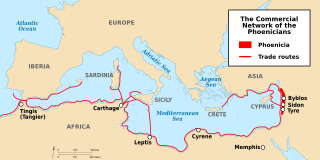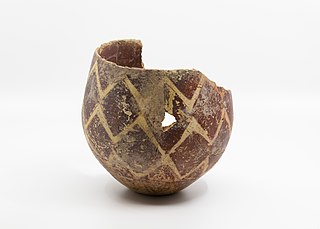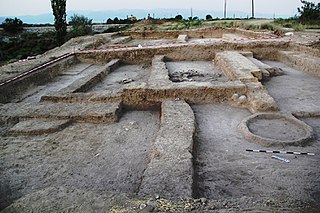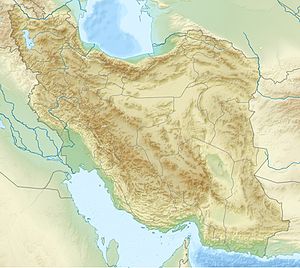
Pistacia is a genus of flowering plants in the cashew family, Anacardiaceae. It contains 10 to 20 species that are native to Africa and Eurasia from the Canary Islands, all of Africa, and southern Europe, warm and semidesert areas across Asia, and North America from Guatemala to Mexico, as well as southern Texas.

A winery is a building or property that produces wine, or a business involved in the production of wine, such as a wine company. Some wine companies own many wineries. Besides wine making equipment, larger wineries may also feature warehouses, bottling lines, laboratories, and large expanses of tanks known as tank farms. Wineries may have existed as long as 8,000 years ago.

Teppe Hasanlu or Hasanlu Tepe is an archeological site of an ancient city located in northwest Iran, a short distance south of Lake Urmia. The nature of its destruction at the end of the 9th century BC essentially froze one layer of the city in time, providing researchers with extremely well preserved buildings, artifacts, and skeletal remains from the victims and enemy combatants of the attack. The site was likely associated with the Mannaeans.
Tepe Sialk is a large ancient archeological site in a suburb of the city of Kashan, Isfahan Province, in central Iran, close to Fin Garden. The culture that inhabited this area has been linked to the Zayandeh River Culture.

Persian wine, also called May, Mul, and Bâdah, is a cultural symbol and tradition in Iran, and has a significant presence in Iranian mythology, Persian poetry and Persian miniatures.

The Shulaveri–Shomu culture, also known as the Shulaveri-Shomutepe-Aratashen culture, is an archaeological culture that existed on the territory of present-day Georgia, Azerbaijan, and Armenia, as well as parts of northern Iran during the Late Neolithic/Eneolithic. It lasted from around the end of the seventh millennium BC to the beginning of the fifth millennium BC.

Godin Tepe is an archaeological site in western Iran, located in the valley of Kangavar in Kermanshah province. The importance of the site may have been due to its role as a trading outpost in the early Mesopotamian trade networks.

The oldest evidence of ancient wine production has been found in Georgia from c. 6000 BC , Iran from c. 5000 BC, Greece from c. 4500 BC, Armenia from c. 4100 BC, and Sicily from c. 4000 BC. The earliest evidence of fermented alcoholic beverage of rice, honey and fruit, sometimes compared to wine, is claimed in China.
Aratashen is a town in the Armavir Province of Armenia. It is located on the Ararat Plain.

The culture of the ancient Phoenicians was one of the first to have had a significant effect on the history of wine. Phoenicia was a civilization centered in current day Lebanon. Between 1550 BC and 300 BC, the Phoenicians developed a maritime trading culture that expanded their influence from the Levant to North Africa, the Greek Isles, Sicily, and the Iberian Peninsula. Through contact and trade, they spread not only their alphabet but also their knowledge of viticulture and winemaking, including the propagation of several ancestral varieties of the Vitis vinifera species of wine grapes.

The Gadar River rises in the Iranian Zagros Mountains close to where the borders of Iran, Turkey and Iraq meet. From its source, the river flows towards the southeast and then changes course due east through the Ushnu-Solduz valley. After leaving the valley, the river turns north and flows into the marshes bordering the endorheic saltwater Lake Urmia. The length of the river is approximately 100 kilometres (62 mi), its drainage basin is variously estimated as 1,900 square kilometres (730 sq mi) and 2,123 square kilometres (820 sq mi) and its discharge is 0.34 cubic metres (12 cu ft) per second. The Ushnu-Solduz valley has been occupied for many millennia, as testified by the excavations at sites like Hasanlu Tepe and Hajji Firuz Tepe.

The prehistory of the Iranian plateau, and the wider region now known as Greater Iran, as part of the prehistory of the Near East is conventionally divided into the Paleolithic, Epipaleolithic, Neolithic, Chalcolithic, Bronze Age and Iron Age periods, spanning the time from the first settlement by archaic humans about a million years ago until the beginning of the historical record during the Neo-Assyrian Empire, in the 8th century BC.

Patrick Edward McGovern is the scientific director of the Biomolecular Archaeology Laboratory for Cuisine, Fermented Beverages, and Health at the University of Pennsylvania Museum in Philadelphia, where he is also an adjunct professor of anthropology. In the popular imagination, he is known as the "Indiana Jones of Ancient Ales, Wines, and Extreme Beverages"

Jeitun (Djeitun) is an archaeological site of the Neolithic period in southern Turkmenistan, about 30 kilometers north of Ashgabat in the Kopet-Dag mountain range. The settlement was occupied from about 7200 to 4500 BC possibly with short interruptions. Jeitun has given its name to the whole Neolithic period in the foothills of the Kopet Dag.
Kul Tepe Jolfa is an ancient archaeological site in the Jolfa County of Iran, located in the city of Hadishahr, about 10 km south from the Araxes River.

Dalma culture was a prehistoric archaeological culture of north-western Iran dating to early fifth millennium B.C. Later, it spread into the central Zagros region and elsewhere in adjacent areas. Its widespread ceramic remains were excavated in central and northern valleys of the Zagros Mountains in north-western Iran. Dalma assemblages were initially discovered by the excavations carried out at Dalma Tepe and Hasanlu Tepe in south-western parts of Lake Urmia, in the valley of Solduz.

Dalma Tepe is an archaeological site about 2km northeast of Naqadeh, Naqadeh County, in the Iranian province of West Azerbaijan. It is the type site of Dalma culture, a prehistoric culture of north-western Iran from the fifth millennium B.C.

Godedzor is a prehistorical archaeological site located about 1,5 kilometres west of the village of Angeghakot in the Syunik Province of Armenia. The settlement of Nerkin Godedzor is in the Vorotan river gorge, at the altitude of 1800 meters. Some petroglyphs are also found close by.

Nakhchivan Tepe (Naxçıvantəpə) is a Chalcolithic settlement in Nakhchivan, Azerbaijan. It is located in Nakhchivan (city) and is dated to the first half of the 5th millennium BC. It is on the right bank of the Nakhchivançay river at the altitude of 850m.


















